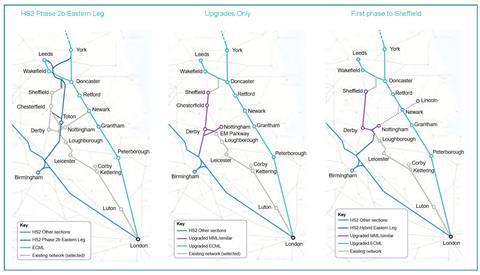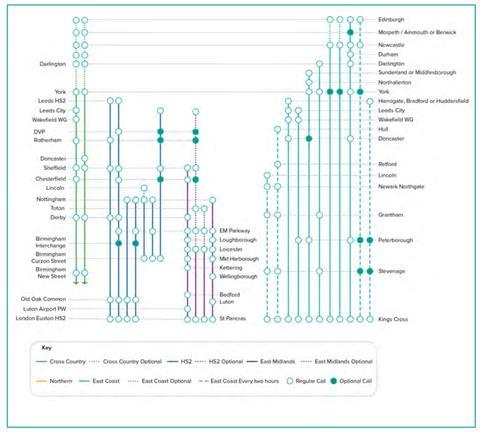
UK: A report prepared by Mott MacDonald outlining strategic alternatives to the Eastern Leg of Phase 2b of High Speed 2, suggests that none of the options considered were likely to deliver the same strategic benefits as the proposed high speed line, although they would reduce the capital expenditure.
Released by the government on January 25, the report was completed in October 2021. It was commissioned to inform the government’s Integrated Rail Plan for the North & Midlands, which was published on November 18.
IRP pared back the planned Eastern Leg of HS2, which would have seen a new line built from a junction near Birmingham to Leeds and a connection with the East Coast Main Line south of York, via a new hub at Toton between Nottingham and Derby. Instead, it proposed that the descoped line should only run from Birmingham to meet the Midland Main Line at East Midlands Parkway, where trains would join the existing network to serve Nottingham, Derby, Sheffield and Leeds.
Terms of reference
Mott MacDonald was commissioned to support DfT in the development of IRP by examining strategic alternatives to the Eastern Leg, building on work undertaken by Atkins in 2016.
The alternatives assessment was undertaken to meet the following objectives:
- address major capacity, frequency and speed shortfalls on the existing network;
- tackle key performance and reliability constraints;
- deliver benefits to those places due to be served by the HS2 Eastern Leg, as well as destinations further afield;
- minimise detrimental impacts on communities;
- avoid disadvantaging existing passengers and other users.
The report says the most recent estimated cost for the Eastern Leg was £32bn in 2019 prices at maximum contingency, ‘which may be unaffordable alongside other major investments’. The alternatives considered were intended to deliver ‘a range of transformational benefits but at a lower cost’.
Four options

The study looked at four alternative concepts, ranging from ‘upgrades to the conventional lines only to a combination of new line and upgrades’. These were:
- a ‘do minimum’ package, replacing the whole of the Eastern Leg with modernisation of the ECML, MML and the Derby – Burton – Tamworth line;
- First Phase to Sheffield, replacing the Eastern Leg by a new HS2 alignment from Birmingham to the Midland Main Line near East Midlands Parkway;
- First Phase to Leeds, replacing the Eastern Leg by a new HS2 alignment from Birmingham to EMP, and building the Leeds HS2 station as planned, but connected to the Woodlesford Line near Hunslet. The existing railway between Hunslet and Hare Park would be upgraded and combined with Northern Powerhouse Rail proposals between Sheffield and South Kirby.
The review also considered two alternative ‘end states’ for the Eastern Leg, which could build upon these options. They were:
The Erewash Alignment, which would cover upgrades to the Erewash Valley Line and the Chesterfield – Masborough Junction route, along with the construction of a new high speed line between Rotherham and Leeds, broadly similar to the planned Eastern Leg, including the proposed HS2 station in Leeds.
The Newark Alignment would route trains from Nottingham past Newark and parallel to the ECML. The proposal assumed a large scale of intervention, comprising a new line east of Nottingham, crossing the ECML outside Newark and bypassing the ECML to the east and north of Doncaster. This would be combined with junctions on/off the ECML at Newark, Bawtry and north of Doncaster, as well as an upgraded conventional route to Leeds via Normanton and Woodlesford. The final approach into the centre of Leeds and the HS2 station in Leeds would be the same for as the Eastern Leg.
Lower cost, fewer benefits
In IRP, the government suggested that its preference would be an option that closely matches the First Phase to Sheffield package outlined by Mott MacDonald.
However, Mott MacDonald concludes that while this choice would ‘potentially be less than a third of the cost of the Eastern Leg, it would not deliver many of the benefits for locations further north that would occur if the Eastern Leg went ahead as planned, and so would seem unlikely to meet the government’s strategic priorities’. An initial estimate suggests the cost would be between £10bn and £11·4bn.

The consultants add that ‘as an interim state this alternative may offer a good compromise of rail improvements and costs savings’. It could ‘lay the foundation for future implementation of the Erewash or Newark routes of the Eastern Leg or indeed, for a continuation of the original HS2 scheme north thereof’.
Under the First Phase to Sheffield plan, Derby and Nottingham would see the most significant cuts in journey times, generally exceeding those on offer from the HS2 Eastern Leg. This is mostly driven by removing the need for passengers to change at the proposed parkway station at Toton. By contrast, many core flows would see no journey time improvements at all — the current Birmingham – Leeds timing of 1 h 57 min would fall to 49 min with HS2, but does not improve with First Phase to Sheffield. London – Leeds timings today are typically 2 h 13 min via ECML, and would only be reduced by 20 min under the proposals, compared to more than a 50 min reduction with HS2.
| Selected journey times as assessed by Mott MacDonald | |||
|---|---|---|---|
|
Route |
Do Minimum/current timing |
HS2 2b Eastern Leg |
First Phase to Sheffield option |
|
London – Sheffield |
1:59 |
1:27 |
1:27 |
|
London – Leeds |
2:13 |
1:21 |
1:53 |
|
London – Nottingham |
1:38 |
1:23 |
0:57 |
|
Birmingham – Leeds |
1:57 |
0:49 |
1:57 |
|
Birmingham – Newcastle |
3:14 |
1:57 |
3:14 |
|
London – Newcastle |
2:49 |
2:17 |
2:25 |
Supporting documents
Click link to download and view these filesMott MacDonald-strategic-alternatives-to-high-speed-2-phase-2b
PDF, Size 1.94 mb



